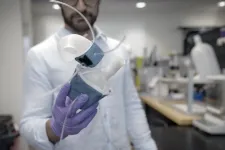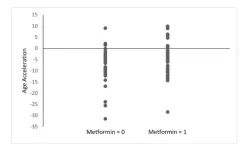(Press-News.org) If the emergence of mechanically propelled weapons in prehistory is commonly perceived as one of the hallmarks of the advance of modern human populations into the European continent, the existence of archery has always been more difficult to trace. The recognition of these technologies in the European Upper Paleolithic has been hampered by ballistic overlaps between weapons projected with a thruster or a bow. Archery technologies are essentially based on the use of perishable materials; wood, fibers, leather, resins, and sinew, which are rarely preserved in European Paleolithic sites and make archaeological recognition of these technologies difficult. It is the flint armatures that constitute the main evidence of these weapon technologies. Based on the analysis of these stone armatures, the recognition of archery is now well documented in Africa dating back some 70,000 years. Some flint or deer antler armatures suggest the existence of archery from the early phases of the Upper Paleolithic in Europe more than 35,000 years ago, but the morphology and the hafting modes of these ancient armatures do not allow them to be linked to a distinct mode of propulsion, making the possible existence of archery during the European Paleolithic nearly invisible. The demonstration of Paleolithic archery has been established only on the basis of the discovery of the oldest bows and arrows found in peat bogs of Northern Europe (at the Stellmoor site in Germany, for example) and dated from the 10 to 12 millennium.
The data from Mandrin cave in Mediterranean France, presented in an article published Wednesday, February 22, 2023 in the journal Science Advances, profoundly enriches our knowledge of these technologies in Europe and now allows us to push back the age of archery in Europe by more than... 40 millennia! The study is based on the functional analysis of thousands of flint artifacts from the same archaeological level that revealed in February 2022 the oldest occupation of modern humans on the European continent. This very rich level, attributed to the Neronian culture, testifies to Homo sapiens occupations dating back to the 54th millennium and is interposed between numerous Neanderthal occupations occupying the cave before and after the modern human installations. The excavation of the Neronian settlement phases has revealed no less than 1500 flint points. Their analysis shows that a significant number of them were used as armatures for arrows propelled with a bow. It is the very small size and more precisely the small width of these armatures, of which some 30% weigh hardly more than a few grams, which allows us to exclude any other mode of ballistic propulsion for these very small weapons. If thanks to this study, archery in Europe, and more broadly throughout Eurasia, makes a remarkable leap back in time, it also sheds light on the weaponry of Neanderthal populations. The study shows that Neanderthals, contemporaries of Neronian modern humans, did not develop mechanically propelled weapons (like technologies using bows or thrusters) and continued to use their traditional weapons based on the use of massive spear-shaped points that were thrusted or thrown by hand, and thus requiring close contact with their game. The traditions and technologies mastered by these two populations were thus profoundly distinct, illustrating a remarkable objective technological advantage to modern populations during their expansion into the European continent. However, in their article, the authors place this debate in a much broader context in which technical choices cannot be limited solely to the cognitive capacities of differing human populations, referring us to the weight of traditions within these Neanderthal and modern human populations as well as to ethologies that may have been profoundly divergent between them.
END
Bow-and-arrow, technology of the first modern humans in Europe 54,000 years ago at Mandrin, France
2023-02-22
ELSE PRESS RELEASES FROM THIS DATE:
Climate change, urbanization drive major declines in L.A.’s birds
2023-02-22
Berkeley — Climate change isn’t the only threat facing California’s birds. Over the course of the 20th century, urban sprawl and agricultural development have dramatically changed the landscape of the state, forcing many native species to adapt to new and unfamiliar habitats.
In a new study, biologists at the University of California, Berkeley, use current and historical bird surveys to reveal how land use change has amplified — and in some cases mitigated — the impacts of climate ...
Twin-bioengine self-adaptive micro/nanorobots developed for gastrointestinal inflammation therapy
2023-02-22
Micro/nanorobots with self-propelling and -navigating capabilities have attracted extensive attention in drug delivery and therapy owing to their controllable locomotion in hard-to-reach body tissues.
However, developing self-adaptive micro/nanorobots that can adjust their driving mechanisms across multiple biological barriers to reach distant lesions is still a challenge.
Recently, a research team led by Prof. CAI Lintao from the Shenzhen Institute of Advanced Technology (SIAT) of the Chinese Academy ...
Custom, 3D-printed heart replicas look and pump just like the real thing
2023-02-22
No two hearts beat alike. The size and shape of the the heart can vary from one person to the next. These differences can be particularly pronounced for people living with heart disease, as their hearts and major vessels work harder to overcome any compromised function.
MIT engineers are hoping to help doctors tailor treatments to patients’ specific heart form and function, with a custom robotic heart. The team has developed a procedure to 3D print a soft and flexible replica of a patient’s heart. They can then ...
Professor Guido Kroemer will inaugurate Redox Medicine 2023 by Highlighting the Hallmarks of Aging & Redox Medicine
2023-02-22
The 25th International Conference on Redox Medicine, on June 21-23 in Paris, will revolutionize tomorrow’s medicine through redox. The translation of basic knowledge of redox into molecular medicine will be extensively discussed.
Prof. Guido Kroemer from the Université de Paris Cité, Hôpital Européen George Pompidou - AP-HP, is the key note speaker for this year. It is a great opportunity to share with Guido Kroemer his favorite topics and to have a unique moment of exchange with him.
Hallmarks of Aging & Redox Medicine: An Expanding Universe
Prof. Kroemer will highlight the “hallmarks of ageing: genomic instability, ...
WVU physicists give the first law of thermodynamics a makeover
2023-02-22
West Virginia University physicists have made a breakthrough on an age-old limitation of the first law of thermodynamics.
Paul Cassak, professor and associate director of the Center for KINETIC Plasma Physics, and graduate research assistant Hasan Barbhuiya, both in the Department of Physics and Astronomy, are studying how energy gets converted in superheated plasmas in space. Their findings, funded by a grant from the National Science Foundation and published in the Physical Review Letters journal, will revamp ...
Yeast used in production of cachaça can prevent asthma, study shows
2023-02-22
A daily dose of a strain of brewer’s yeast used to produce cachaça (distilled spirit made from fermented sugarcane juice) can act as a preventive against asthma, according to a Brazilian study involving male mice. The results are reported in an article published in the journal Probiotics and Antimicrobial Proteins. The authors are researchers at the University of São Paulo (USP) and the Federal University of Minas Gerais (UFMG). The yeast strain used in the study was Saccharomyces cerevisiae UFMG A-905.
Asthma is a common lung condition that causes breathing difficulties. It ...
Out of the blue
2023-02-22
(Santa Barbara, Calif.) — Blue foods — those that come from the ocean or freshwater environments — have tremendous potential to help address several global challenges. With careful implementation of policies that leverage these foods, nations could get a boost on efforts to reduce nutritional deficits, lower disease risk, decrease greenhouse gas emissions and ensure resilience in the face of climate change.
So say the team of experts at Blue Food Assessment, an international collaboration of scientists whose focus has been on the role of aquatic foods in global ...
Hands-free tech adds realistic sense of touch in extended reality
2023-02-22
HOUSTON – (Feb. 22, 2023) – With an eye toward a not-so-distant future where some people spend most or all of their working hours in extended reality, researchers from Rice University, Baylor College of Medicine and Meta Reality Labs have found a hands-free way to deliver believable tactile experiences in virtual environments.
Users in virtual reality (VR) have typically needed hand-held or hand-worn devices like haptic controllers or gloves to experience tactile sensations of touch. The new “multisensory pseudo-haptic” technology, which is described in an open-access ...
Physically demanding work tied to higher male fertility, study suggests
2023-02-22
A new study from researchers from Brigham and Women’s Hospital, a founding member of the Mass General Brigham healthcare system, suggests that men who regularly lift heavy objects at work have higher sperm counts. The study, published in Human Reproduction, is part of the Environment and Reproductive Health (EARTH) cohort, a clinical study which aims to explore how exposure to environmental chemicals and lifestyle choices affect reproductive health.
“We already know that exercise is associated with multiple health benefits in humans, including those observed on reproductive health, but few studies have looked at how occupational factors can ...
Aging | Metformin's impact on aging and longevity through DNA methylation
2023-02-22
“In this study, we compared genome-wide DNA methylation rates among metformin users and nonusers [...]”
BUFFALO, NY- February 22, 2023 – A new research paper was published in Aging (listed as "Aging (Albany NY)" by MEDLINE/PubMed and "Aging-US" by Web of Science) Volume 15, Issue 3, entitled, “Metformin use history and genome-wide DNA methylation profile: potential molecular mechanism for aging and longevity.”
Metformin, a commonly prescribed anti-diabetic medication, has repeatedly been shown to hinder aging in pre-clinical ...







